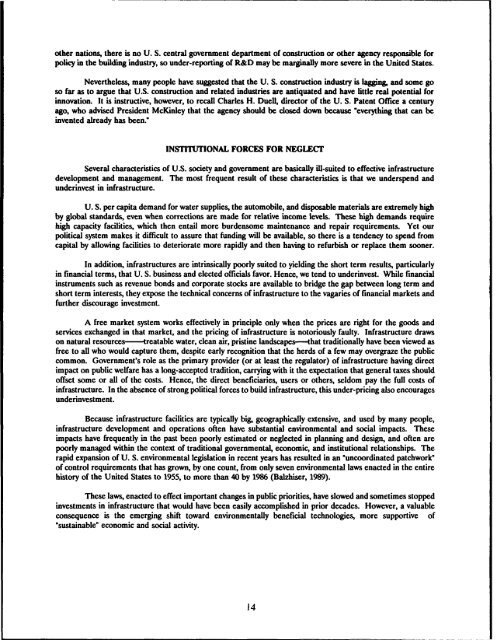Challenges and Opportunities for Innovation in the Public Works ...
Challenges and Opportunities for Innovation in the Public Works ...
Challenges and Opportunities for Innovation in the Public Works ...
Create successful ePaper yourself
Turn your PDF publications into a flip-book with our unique Google optimized e-Paper software.
o<strong>the</strong>r nations, <strong>the</strong>re is no U. S. central government department of construction or o<strong>the</strong>r agency responsible <strong>for</strong><br />
policy <strong>in</strong> <strong>the</strong> build<strong>in</strong>g <strong>in</strong>dustry, so under-report<strong>in</strong>g of R&D may be marg<strong>in</strong>ally more severe <strong>in</strong> <strong>the</strong> United States.<br />
Never<strong>the</strong>less, many people have suggested that <strong>the</strong> U. S. construction <strong>in</strong>dustry is lagg<strong>in</strong>g, <strong>and</strong> some go<br />
so far as to argue that U.S. construction <strong>and</strong> related <strong>in</strong>dustries are antiquated <strong>and</strong> have little real potential <strong>for</strong><br />
<strong>in</strong>novation. It is <strong>in</strong>structive, however, to recall Charles H. Duell, director of <strong>the</strong> U. S. Patent Office a century<br />
ago, who advised President McK<strong>in</strong>ley that <strong>the</strong> agency should be dosed down because "everyth<strong>in</strong>g that can be<br />
<strong>in</strong>vented already has been."<br />
INSTITUTIONAL FORCES FOR NEGLECT<br />
Several characteristics of U.S. society <strong>and</strong> government are basically ill-suited to effective <strong>in</strong>frastructure<br />
development <strong>and</strong> management. The most frequent result of <strong>the</strong>se characteristics is that we underspend <strong>and</strong><br />
under<strong>in</strong>vest <strong>in</strong> <strong>in</strong>frastructure.<br />
U. S. per capita dem<strong>and</strong> <strong>for</strong> water supplies, <strong>the</strong> automobile, <strong>and</strong> disposable materials are extremely high<br />
by global st<strong>and</strong>ards, even when corrections are made <strong>for</strong> relative <strong>in</strong>come levels. These high dem<strong>and</strong>s require<br />
high capacity facilities, which <strong>the</strong>n entail more burdensome ma<strong>in</strong>tenance <strong>and</strong> repair requirements. Yet our<br />
political system makes it difficult to assure that fund<strong>in</strong>g will be available, so <strong>the</strong>re is a tendency to spend from<br />
capital by allow<strong>in</strong>g facilities to deteriorate more rapidly <strong>and</strong> <strong>the</strong>n hav<strong>in</strong>g to refurbish or replace <strong>the</strong>m sooner.<br />
In addition, <strong>in</strong>frastructures are <strong>in</strong>tr<strong>in</strong>sically poorly suited to yield<strong>in</strong>g <strong>the</strong> short term results, particularly<br />
<strong>in</strong> f<strong>in</strong>ancial terms, that U. S. bus<strong>in</strong>ess <strong>and</strong> elected officials favor. Hence, we tend to under<strong>in</strong>vest. While f<strong>in</strong>ancial<br />
<strong>in</strong>struments such as revenue bonds <strong>and</strong> corporate stocks are available to bridge <strong>the</strong> gap between long term <strong>and</strong><br />
short term <strong>in</strong>terests, <strong>the</strong>y expose <strong>the</strong> technical concerns of <strong>in</strong>frastructure to <strong>the</strong> vagaries of f<strong>in</strong>ancial markets <strong>and</strong><br />
fur<strong>the</strong>r discourage <strong>in</strong>vestment.<br />
A free market system works effectively <strong>in</strong> pr<strong>in</strong>ciple only when <strong>the</strong> prices are right <strong>for</strong> <strong>the</strong> goods <strong>and</strong><br />
services exchanged <strong>in</strong> that market, <strong>and</strong> <strong>the</strong> pric<strong>in</strong>g of <strong>in</strong>frastructure is notoriously faulty. Infrastructure draws<br />
on natural resources -treatable water, clean air, prist<strong>in</strong>e l<strong>and</strong>scapes---that traditionally have been viewed as<br />
free to all who would capture <strong>the</strong>m, despite early recognition that <strong>the</strong> herds of a few may overgraze <strong>the</strong> public<br />
common. Government's role as <strong>the</strong> primary provider (or at least <strong>the</strong> regulator) of <strong>in</strong>frastructure hav<strong>in</strong>g direct<br />
impact on public welfare has a long-accepted tradition, carry<strong>in</strong>g with it <strong>the</strong> expectation that general taxes should<br />
offset some or all of <strong>the</strong> costs. Hence, <strong>the</strong> direct beneficiaries, users or o<strong>the</strong>rs, seldom pay <strong>the</strong> full costs of<br />
<strong>in</strong>frastructure. In <strong>the</strong> absence of strong political <strong>for</strong>ces to build <strong>in</strong>frastructure, this under-pric<strong>in</strong>g also encourages<br />
under<strong>in</strong>vestment.<br />
Because <strong>in</strong>frastructure facilities are typically big, geographically extensive, <strong>and</strong> used by many people,<br />
<strong>in</strong>frastructure development <strong>and</strong> operations often have substantial environmental <strong>and</strong> social impacts. These<br />
impacts have frequently <strong>in</strong> <strong>the</strong> past been poorly estimated or neglected <strong>in</strong> plann<strong>in</strong>g <strong>and</strong> design, <strong>and</strong> often are<br />
poorly managed with<strong>in</strong> <strong>the</strong> context of traditional governmental, economic, <strong>and</strong> <strong>in</strong>stitutional relationships. The<br />
rapid expansion of U. S. environmental legislation <strong>in</strong> recent years has resulted <strong>in</strong> an "uncoord<strong>in</strong>ated patchwork"<br />
of control requirements that has grown, by one count, from only seven environmental laws enacted <strong>in</strong> <strong>the</strong> entire<br />
history of <strong>the</strong> United States to 1955, to more than 40 by 1986 (Balzhiser, 1989).<br />
These laws, enacted to effect important changes <strong>in</strong> public priorities, have slowed <strong>and</strong> sometimes stopped<br />
<strong>in</strong>vestments <strong>in</strong> <strong>in</strong>frastructure that would have been easily accomplished <strong>in</strong> prior decades. However, a valuable<br />
consequence is <strong>the</strong> emerg<strong>in</strong>g shift toward environmentally beneficial technologies, more supportive of<br />
"susta<strong>in</strong>able" economic <strong>and</strong> social activity.<br />
14







